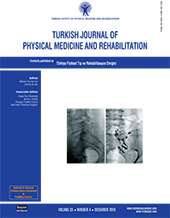Bilateral pan-plexus lesion after substance use: A case report
2 Department of Neurology, Gazi University Faculty of Medicine, Ankara, Turkey DOI : 10.5606/tftrd.2019.3157 Peripheral nervous system complications such as acute demyelinating polyradiculopathy and mononeuropathy may rarely develop after substance use. A 27-year-old man used illegal drugs the day before his admission to the emergency service. Initially, he was suspected for rhabdomyolysis, due to elevated blood urea nitrogen, creatinine, aspartate aminotransferase, alanine aminotransferase, myoglobin, and creatine kinase levels. On Day 4, generalized edema and flask paralysis were noted in both upper limbs. The patient was diagnosed with bilateral brachial pan-plexopathy based on electrophysiological study results. He underwent a rehabilitation program. After eight months, repeated electrophysiological study revealed a significant improvement in all bilateral upper limb muscles, except for the right abductor pollicis brevis and abductor digiti minimi muscles. The underlying cause of bilateral brachial pan-plexopathy was rhabdomyolysis secondary to substance use. In conclusion, substance use in patients with non-traumatic plexopathy should always be questioned. Keywords : Brachial plexus, rhabdomyolysis, substance use


















